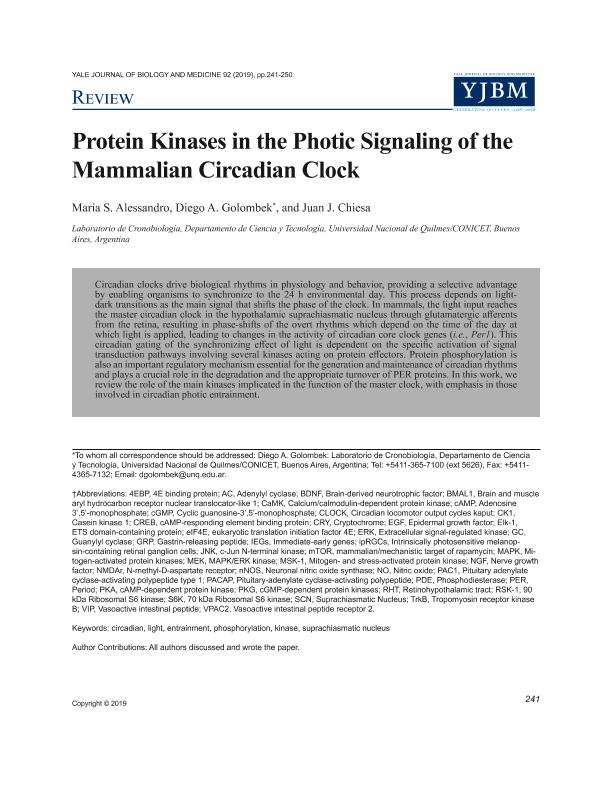Mostrar el registro sencillo del ítem
dc.contributor.author
Alessandro, Maria Soledad

dc.contributor.author
Golombek, Diego Andrés

dc.contributor.author
Chiesa, Juan José

dc.date.available
2021-05-07T01:20:33Z
dc.date.issued
2019-06-27
dc.identifier.citation
Alessandro, Maria Soledad; Golombek, Diego Andrés; Chiesa, Juan José; Protein kinases in the photic signaling of the mammalian circadian clock; Yale School of Medicine; Yale Journal of Biology and Medicine; 92; 2; 27-6-2019; 241-250
dc.identifier.issn
1551-4056
dc.identifier.uri
http://hdl.handle.net/11336/131577
dc.description.abstract
Circadian clocks drive biological rhythms in physiology and behavior, providing a selective advantage by enabling organisms to synchronize to the 24 h environmental day. This process depends on lightdark transitions as the main signal that shifts the phase of the clock. In mammals, the light input reaches the master circadian clock in the hypothalamic suprachiasmatic nucleus through glutamatergic afferents from the retina, resulting in phase-shifts of the overt rhythms which depend on the time of the day at which light is applied, leading to changes in the activity of circadian core clock genes (i.e., Per1). This circadian gating of the synchronizing effect of light is dependent on the specific activation of signal transduction pathways involving several kinases acting on protein effectors. Protein phosphorylation is also an important regulatory mechanism essential for the generation and maintenance of circadian rhythms and plays a crucial role in the degradation and the appropriate turnover of PER proteins. In this work, we review the role of the main kinases implicated in the function of the master clock, with emphasis in those involved in circadian photic entrainment.
dc.format
application/pdf
dc.language.iso
eng
dc.publisher
Yale School of Medicine
dc.rights
info:eu-repo/semantics/openAccess
dc.rights.uri
https://creativecommons.org/licenses/by-nc/2.5/ar/
dc.subject
Circadian
dc.subject
Light
dc.subject
Entrainment
dc.subject
Phosphorylation
dc.subject
Kinase
dc.subject
Suprachiasmatic nucleus
dc.subject.classification
Biología

dc.subject.classification
Ciencias Biológicas

dc.subject.classification
CIENCIAS NATURALES Y EXACTAS

dc.title
Protein kinases in the photic signaling of the mammalian circadian clock
dc.type
info:eu-repo/semantics/article
dc.type
info:ar-repo/semantics/artículo
dc.type
info:eu-repo/semantics/publishedVersion
dc.date.updated
2021-04-19T14:06:59Z
dc.journal.volume
92
dc.journal.number
2
dc.journal.pagination
241-250
dc.journal.pais
Estados Unidos

dc.description.fil
Fil: Alessandro, Maria Soledad. Universidad Nacional de Quilmes. Departamento de Ciencia y Tecnología. Laboratorio de Cronobiología; Argentina. Consejo Nacional de Investigaciones Científicas y Técnicas; Argentina
dc.description.fil
Fil: Golombek, Diego Andrés. Universidad Nacional de Quilmes. Departamento de Ciencia y Tecnología. Laboratorio de Cronobiología; Argentina. Consejo Nacional de Investigaciones Científicas y Técnicas; Argentina
dc.description.fil
Fil: Chiesa, Juan José. Universidad Nacional de Quilmes. Departamento de Ciencia y Tecnología. Laboratorio de Cronobiología; Argentina. Consejo Nacional de Investigaciones Científicas y Técnicas; Argentina
dc.journal.title
Yale Journal of Biology and Medicine
dc.relation.alternativeid
info:eu-repo/semantics/altIdentifier/url/https://www.ncbi.nlm.nih.gov/pmc/articles/PMC6585524/
dc.relation.alternativeid
info:eu-repo/semantics/altIdentifier/url/https://pubmed.ncbi.nlm.nih.gov/31249485/
Archivos asociados
